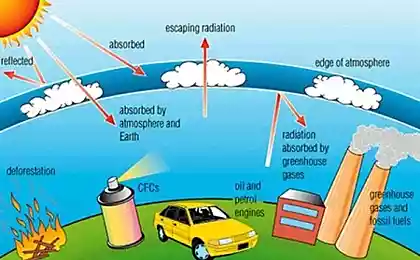1715
Global carbon dioxide emissions continue to increase

Joint Research Centre of the European Commission and the Dutch Directorate for Environmental Assessment published a report on emissions of carbon dioxide last year.
Based on the "Databases emissions for global atmospheric research 'and statistics on the use of energy and related activities (gas flaring and cement production and others.) The researchers concluded that in 2011, emissions increased by 3% to a record high of 34 billion tonnes, despite the decline in OECD countries.
Adverse economic conditions, mild winters and high oil prices have led to the fact that the European Union emissions dropped by 3%, while the US and Japan - 2%. OECD countries now account for only one-third of global emissions. The second third belongs to China and India, where emissions increased by 9% and 6% respectively.
In China, the most populous country in the world per capita emissions by 7, 2 t. Thus, the Celestial Empire joined the club of industrialized countries (compared to the EU index - 7, 5 t, USA - 17, 3 tons). China's economic growth has led to a significant increase in consumption of fossil fuels. The mere increase in the production of cement and steel forced to increase coal consumption by 9, 7%.
World growth in emissions by 3% in 2011 was higher than the average annual increase in the last decade, which was 2, 7%. The main producers are China (29%), the US (16%), European Union (11%), India (6%), Russia (5%) and Japan (4%).
It is estimated that from 2000 to 2011 as a result of human activity has been thrown a total of 420 billion tons of carbon dioxide (including deforestation). In this situation, limiting the growth in average global temperature to two degrees (above pre-industrial levels) - a goal adopted in international negotiations under the auspices of the United Nations - is only possible if the total emissions in the first half of the XXI century will not exceed 1-1, 5 trillion m. If the current trend will continue to increase emissions, their total volume exceeds this limit in the next two decades.
Fortunately, the growth has slowed down due to the increased use of renewable energy, particularly solar and wind, as well as biofuels. The global share of this sector (hydropower is not included here) from 1992 to 2011 has quadrupled. In 2011, it saved the atmosphere from 0 to 8 billion tons of carbon dioxide, which is almost equal to the emissions of Germany during the same period.
With country data can be found here (shaft) and here (per capita).
Earlier, his view of the situation promulgated by the International Energy Agency. The figures are slightly different, but the overall picture is the same.























